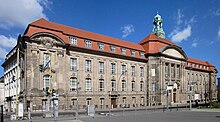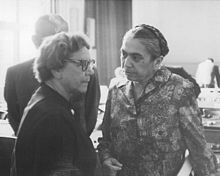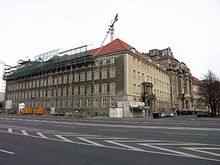Supreme Court of the GDR

Supreme Court (OG) was the name of the highest judicial body in the GDR . It was set up organisationally separate from the General Public Prosecutor of the GDR by law of December 8, 1949 and dissolved when the Unification Treaty came into force .
Until the beginning of the 1970s, the Supreme Court was located in the representative building of the former Military Medical Academy on Invalidenstraße with the postal address “Scharnhorststraße 6” in Berlin-Mitte. It then moved into premises in the local justice building on Littenstrasse . The building also housed the Berlin City Court , the three district courts of Mitte, Prenzlauer Berg and - until he moved out - Friedrichshain, the state notary's office and the attorney general of (Greater) Berlin, the public prosecutors for the districts of Mitte, Prenzlauer Berg and - to to his move - Friedrichshain, the military court and the military chief prosecutor .
Responsibilities
The duties of the court included
- the implementation of criminal proceedings in the first and last instance in which the Supreme Public Prosecutor of the GDR brought charges before the Supreme Court because of the paramount importance of the cases, and
- the cassation in civil and criminal matters.
Other tasks were added later, which is mainly due to the process of simplification that the GDR judiciary went through. According to § 55 of the Courts Constitution Act of the GDR, which came into force on October 15, 1952, the Supreme Court, as a court of second instance, had the appeal
- protests, appeals and complaints against first-instance judgments in civil, family and labor law matters as well as in criminal and military criminal matters
- the appeal against decisions of the arbitration board for declarations of nullity of the Office for Inventions and Patents
to negotiate and decide.
In 1959 it was also responsible for East Berlin , where the relevant competencies had previously been held by the East District Court .
The State Contracting Court was responsible for commercial disputes within the nationally owned and cooperative economy . There was no constitutional jurisdiction or special administrative, social and financial court branches in the GDR. For social security matters there was the complaint commissions for social security of the FDGB ( § 302 f. AGB ) and the state insurance ; In administrative law, the possibility of internal administrative appeals as well as more general submissions .
organization
The Supreme Court of the GDR was an ordinary court and decided in both criminal and civil cases. Senates were formed for this purpose, each headed by a president or a vice-president as chief judge. In addition to the chief judge, two other judges sat in a senate. In accordance with the Courts Constitution Act, the judges of the Supreme Court were elected for five years by the People's Chamber on the proposal of the Council of Ministers .
The highest body was the plenary, which included all the judges of the Supreme Court and the directors of the district courts and the three military courts of law . In annual meetings, guidelines and resolutions were passed, which were usually included in the GDR's legal gazette.
The affairs of the Supreme Court were governed by the Presidium, which consisted of the President, the Vice-President and the Chief Justice. The Presidium could also pass resolutions for the jurisdiction of lower courts. The Grand Senate of the Supreme Court had to make decisions of principle. Depending on whether the Grand Senate had to decide on criminal or civil matters, the college of judges consisted of the chief judges of the respective criminal or civil senates as well as the president and vice-president of the court.
- Presidents: Kurt Schumann (1949–1960, NDPD ), Heinrich Toeplitz (1960–1986, CDU ), Günter Sarge (1986–1990, SED ); Gerhard Körner (February to October 1990, PDS ).
- Vice-Presidents: Hilde Benjamin (1949–1953, SED); Vice President and Chairman of the College of Criminal Law: Walter Ziegler (1953–1958, SED), Gustav Jahn (1958–1962), Walter Ziegler (1962–1977, SED), (new 1st Vice President) Günter Sarge (1977–1986, SED ); from 1977 five criminal senates;
- Vice-President and Chairman of the College for Civil, Family and Labor Law: Hans Reinwarth (1966–1969), Peter-Paul Siegert (1969–1974), Werner Strasberg (1974–1990; from 1986 1st Vice-President); from 1978 four civil senates;
- Military College: Chairman of the College: Günter Sarge (1963–1977), Lothar Penndorf (1977–1989) responsible for MdI, MfNV and MfS; from 1971 two military criminal senates;
- Attorneys-General not subordinate to the Supreme Court (see GDR Justice ): Ernst Melsheimer (1949–1960, SED), Josef Streit (1962–1986, SED), Günter Wendland (1986–1989), Harri Harrland (1989/1990), Hans -Jürgen Joseph (1-6 / 1990);
- Deputy Attorney General: Günter Wendland (until 1986), Karl-Heinz Borchert, from 1990 among others Lothar Reuter and Peter Przybylski (long-time press spokesman / public prosecutor for public relations, including in the DFF television program The public prosecutor has the floor ).
In 1989 there were 58 judges at the Supreme Court; 119 public prosecutors at the Attorney General.
The 1st criminal senate
In the 1st Criminal Senate of the Supreme Court, especially in the early years of the GDR, decisive processes of high political relevance for the history of the GDR were negotiated, such as the trial against Jehovah's Witnesses (1950), against Otto Fleischer (1953), Elli Barczatis / Karl Laurenz (1955), which dealt with espionage , or the show trial of Hans Globke , a close advisor to Konrad Adenauer , because of his National Socialist past (1963). From 1950 to 1972 the Criminal Senate conducted 63 trials against 260 people, most of which took place between 1950 and 1957. In the 41 trials involving 202 defendants during this period, only two were acquitted. Among the 200 convictions were
- 17 death sentences (15 of which were carried out );
- 28 times life sentences ;
- 40 times 15 years in prison ;
- 51 times between 10 and 14 years in prison.
From the mid-1960s, the number of proceedings negotiated here decreased. From 1967 onwards there was at most one criminal trial per year before the 1st Criminal Senate.
The vice-president usually presided, rarely the president. In the 1950s in particular, the Criminal Senate passed judgments based on legal principles that were later incorporated into GDR legislation. Ernst Melsheimer , the first attorney general in the GDR, assigned the Senate a central political function:
“The highest court is to rule in the questions that are decisive for the foundations of our state and the existence of our republic; it should judge on a high platform that is widely visible to the whole people; it should judge quickly and correctly. [...] The verdict [...] by the highest court in the broadest public strengthens and deepens the democratic sentiment and the democratic vigilance of the masses. "

The later GDR Justice Minister Hilde Benjamin held several political trials in this room as the first vice-president of the court. She headed the legislative commission at the State Council of the GDR and wrote GDR legal history.
Decision collections
Decisions of the Supreme Court of the German Democratic Republic
- in civil matters (OGZ) 1.1951–16.1983 (decisions from 1950–1981; ZDB -ID 1871-5 and ZDB -ID 224988-1 )
- in criminal matters (OGSt) 1.1951–16.1977 (decisions from 1950–1975; ZDB -ID 1870-3 and ZDB -ID 224987-x )
- in labor law matters (OGA) 1.1959–9.1983 (decisions of the years 1952–1981; ZDB -ID 507535-x and ZDB -ID 224986-8 )
For the period from 1975 or 1981 onwards, no more official collection of decisions was published. Instead, there was that of secrecy underlying information of the Supreme Court of the German Democratic Republic (1977-1989; ZDB -ID 1085540-3 ; 78 issues). Other decisions were published in the journal Neue Justiz .
Register characters
until 1975:
- 1st position: type of procedure
- Z = cassation
- Z… (I) = first instance proceedings
- U = calling
- W = complaint
- 2nd position: field of law
- st = criminal matters (II / III: subject area)
- MSt = military criminal matters
- z = civil matters
- a = labor law matters
- z ... (Pa) = patent matters (1954–63)
- zV / stV = traffic matters (1954–60 / 67)
- zF = family matters (from 1958)
- zP = patent matters (from 1963)
- Pr = Presidium; Pl = plenary session
- Example: Zst (cassation in criminal matters)
from 1976:
- 1st position: court
- O = Supreme Court
- 2nd position: field of law
- S = criminal matters
- MS = military criminal matters
- Z = civil matters
- P = patent matters etc.
- F = family matters
- A = labor law matters
- D = administrative law matters (1989/90)
- 3rd digit: type of procedure
- K = cassation
- B = calling
- R = complaint
- OGrS = Great Senate (1987/90)
- Example: OSK (cassation in criminal matters)
literature
- Rudi Beckert: The first and last instance. Show and secret trials before the Supreme Court of the GDR . Keip Verlag, Goldbach, 1995, p. 20, ISBN 3805102437 .
- Matthias Esch: Cassation in criminal matters . Reports of the Eastern European Institute at the Free University of Berlin, Berlin 1992, ISBN 3-921374-46-4 .
- Karl Wilhelm Fricke: Politics and Justice in the GDR. On the history of political persecution 1945–1968. Cologne 1979, ISBN 3-8046-8568-4 .
- Günther Sarge: In the service of the law: The highest judge in the GDR remembers. Edition Ost, Berlin 2013, ISBN 978-3-360-01844-1 .
- Horst Kellner: The cassation in civil matters in the German Democratic Republic. Dissertation 1957, HU Berlin.
- Directives and resolutions - important management acts of the Supreme Court of the GDR. WissZ der HUB, 1966, issue 6.
- About the role of jurisprudence in the legal education process in the German Democratic Republic , in: Festschrift für Erich Buchholz , Kai Homilius Verlag, Berlin 2007, pp. 140 ff.
Web links
- Federal Archives: DP 2 - Supreme Court of the GDR - Introduction
- Hans-Peter Haferkamp : Justification behavior of the Reichsgericht between 1933 and 1945 in civil matters compared with decisions of the Supreme Court of the GDR before 1958 In: Rainer Schröder (Ed.): Civil law culture of the GDR. Volume 2. Berlin 2000, pp. 15-50
Individual evidence
- ↑ Law on the establishment of the Supreme Court and the Supreme Public Prosecutor's Office of the German Democratic Republic of December 8, 1949 ( Journal of Laws of No. 16 p. 111 )
- ↑ Today the building is the seat of the Central District Court and various civil chambers of the Berlin Regional Court (appeal and appeal chambers, chambers of traffic, chambers of competition, chambers for commercial matters).
- ↑ Torsten Reich: Cassation in Civil Matters - Act of Measure or Legal Institution? . In: forum historiae iuris, 1997
- ↑ Law on the Constitution of the Courts of the German Democratic Republic (Courts Constitution Act) of October 2, 1952 ( Journal of Laws of I No. 141 p. 983 )
- ↑ Guideline on the election, tasks and working methods of the complaint commissions for social insurance of the Free German Trade Union Federation of February 21, 1978 ( Journal of Laws of I No. 8 p. 109 )
- ↑ Ordinance on the election, tasks and working methods of the complaint commissions for social insurance at the State Insurance of the German Democratic Republic (complaints committee regulations) of 4 May 1979 ( Journal of Laws of I No. 14 p. 106 )
- ↑ Law and Ordinance of June 24, 1971 ( Journal I No. 3 p. 49 and Journal II No. 54 p. 465 )
- ↑ Entries Act of June 19, 1975 (Journal of Laws I No. 26 p. 461)
- ↑ Statistical Yearbook of the German Democratic Republic 1990 p. 448
- ↑ Statistics from: Rudi Beckert (see list of literature), p. 20.
- ↑ on this Friedrich-Christian Schroeder , Dieter Gräf: Geheime Jurisdiction Instructions in the GDR . In: Law in East and West (ROW) . Volume 31, 1987, pp. 291-294.
Coordinates: 52 ° 31 '55 " N , 13 ° 22' 22.8" E


